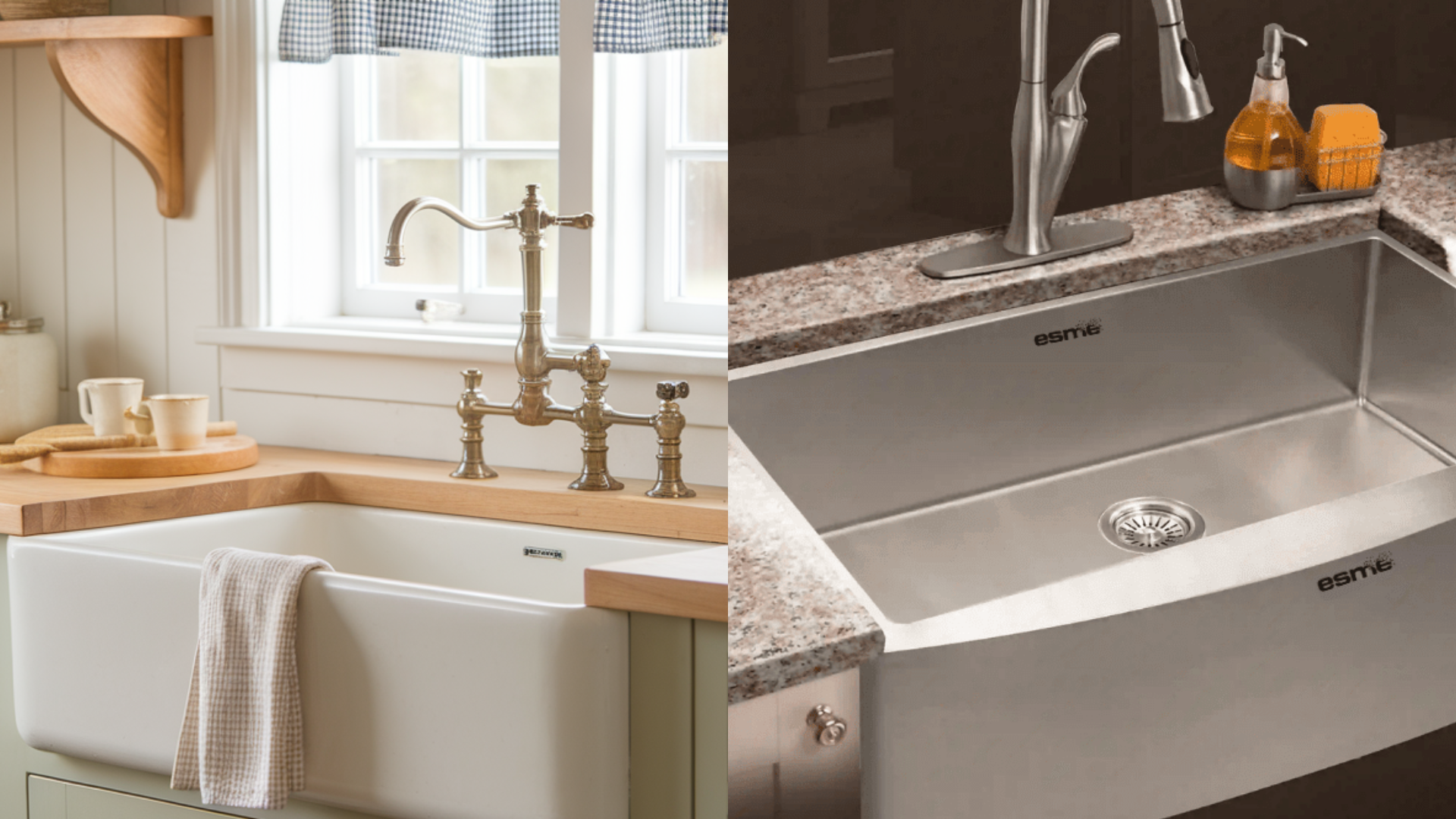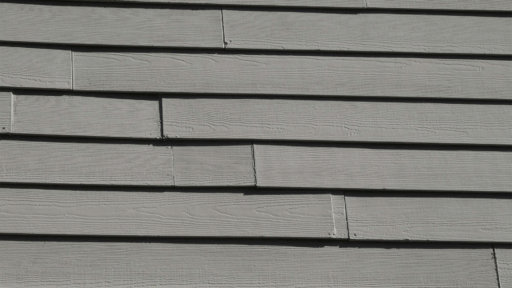When I first started exploring sink options for my kitchen, I kept running into two terms that seemed to mean the same thing: apron sink and farmhouse sink.
At first, I thought they were just two names for one style. Turns out, it’s a little more complicated than that.
Apron sinks are known for their large, exposed front panels, the parts that stick out slightly from the cabinets. Farmhouse sinks often resemble one another but are more closely tied to a style inspired by traditional, rustic farm kitchens.
That’s where the confusion usually starts. Most people (including me at first!) use the terms interchangeably, but not all apron sinks are technically farmhouse sinks.
In this post, I’ll help you understand the real differences so you can make the best choice for your space.
Thinking about upgrading your kitchen? Let’s find the right sink for your style and needs.
Are Apron and Farmhouse Sinks the Same Thing?
The short answer? Not exactly, but they’re closely related. In everyday conversation, people often use an apron sink and a farmhouse sink as if they mean the same thing.
Even some retailers and designers do it. That’s because most farmhouse sinks have a visible front panel, which is the key feature of an apron-front sink. But here’s where it gets a little more specific:
- “Farmhouse sink” usually refers to the style, deep basin, rustic feel, and vintage charm.
- “Apron sink” describes the design feature, the exposed front panel that juts out slightly from the cabinetry.
So, while most farmhouse sinks are apron-front, not every apron-front sink is farmhouse style. Some have sleek, modern designs that bear no resemblance to an old farm kitchen.
Knowing the difference can help you pick the right look and feel for your home.
What Is an Apron-Front Sink?

An apron-front sink is defined by its exposed front panel, also called the “apron,” which slightly protrudes from the surrounding cabinetry.
This design isn’t just for aesthetics; it also brings you closer to the sink, making washing more comfortable. While many apron-front sinks adhere to a farmhouse aesthetic, others exhibit a more modern or minimalist style.
These sinks often require custom cabinet modifications, as they slide into place rather than sitting on top, like drop-in sinks.
Whether rustic or contemporary, apron-front sinks are chosen for their standout style and functional design that enhances everyday kitchen tasks.
What Is a Farmhouse Sink?
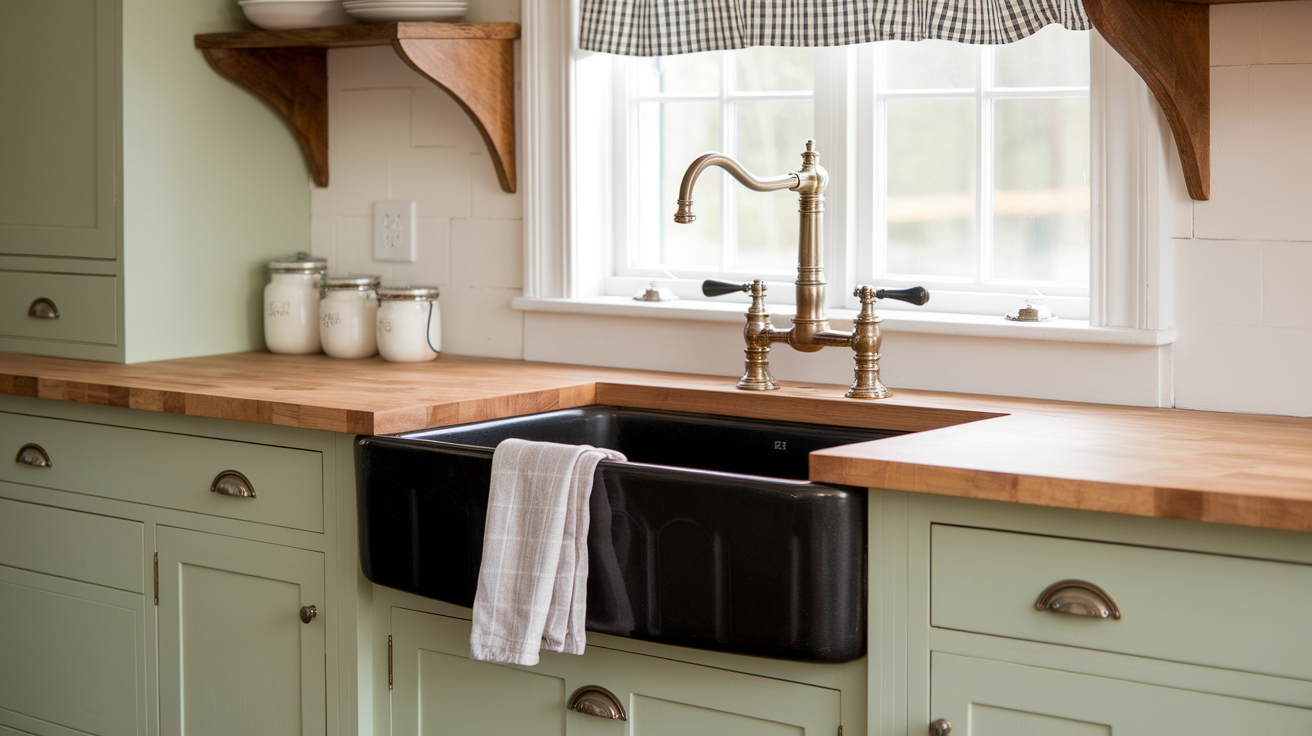
A farmhouse sink is a large, deep sink originally used in country homes before indoor plumbing was common.
These sinks were designed to hold plenty of water and handle everyday chores like washing dishes, food prep, and even laundry.
The most recognizable feature is the exposed front panel, which extends past the cabinet edge and gives the sink a bold, timeless look.
Farmhouse sinks usually have a single, deep basin, making them practical for handling oversized pots and pans. Today, they’re popular in rustic, cottage, and traditional kitchens – but they also blend into modern farmhouse spaces.
Apron Sink vs Farmhouse Sink: Key Differences
Before I chose between an apron sink and a farmhouse sink, I had to look beyond the surface. From design details and daily use to installation needs and cost, I found that these practical differences really made a big impact on my decision.
1. Design Differences
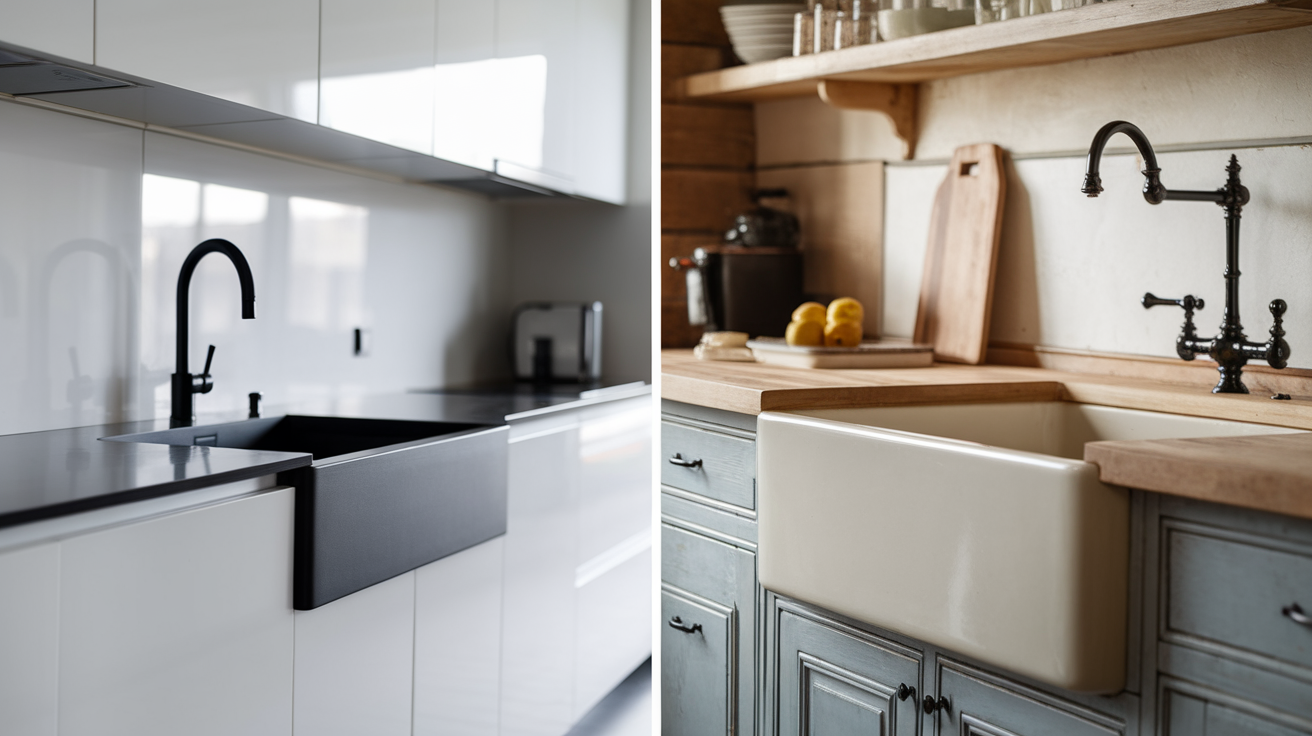
Apron sinks and farmhouse sinks are often confused, but they have key differences.
An apron sink is defined by its exposed front panel that slightly extends beyond the cabinets. This feature appears in both modern and traditional designs.
Modern apron sinks usually have sharp corners and clean lines, making them a great choice for minimalist or transitional kitchens.
A farmhouse sink, meanwhile, is rooted in classic rural home design. It typically has a deep basin and soft, rounded edges. While most farmhouse sinks are apron-front, not every apron sink fits the farmhouse style.
If you’re going for a warm, cozy, and rustic look, a farmhouse sink is likely the better fit for your space.
2. Functionality: Everyday Use and Workflow

One of the best things about both apron and farmhouse sinks is how functional they are in a busy kitchen. Their wide, deep basins easily handle large pots, baking sheets, and meal prep without making you feel cramped.
The apron-front design lets you stand closer to the sink, which helps reduce back strain during long dishwashing sessions.
Farmhouse sinks usually come with a single, deep basin, though double-basin versions are available too. Apron sinks can sometimes be a bit shallower, depending on the style.
Either option is great if you cook often, host guests, or have a big family. They also make it easier to rinse produce or fill tall pots.
3. Installation Styles and Cabinet Requirements
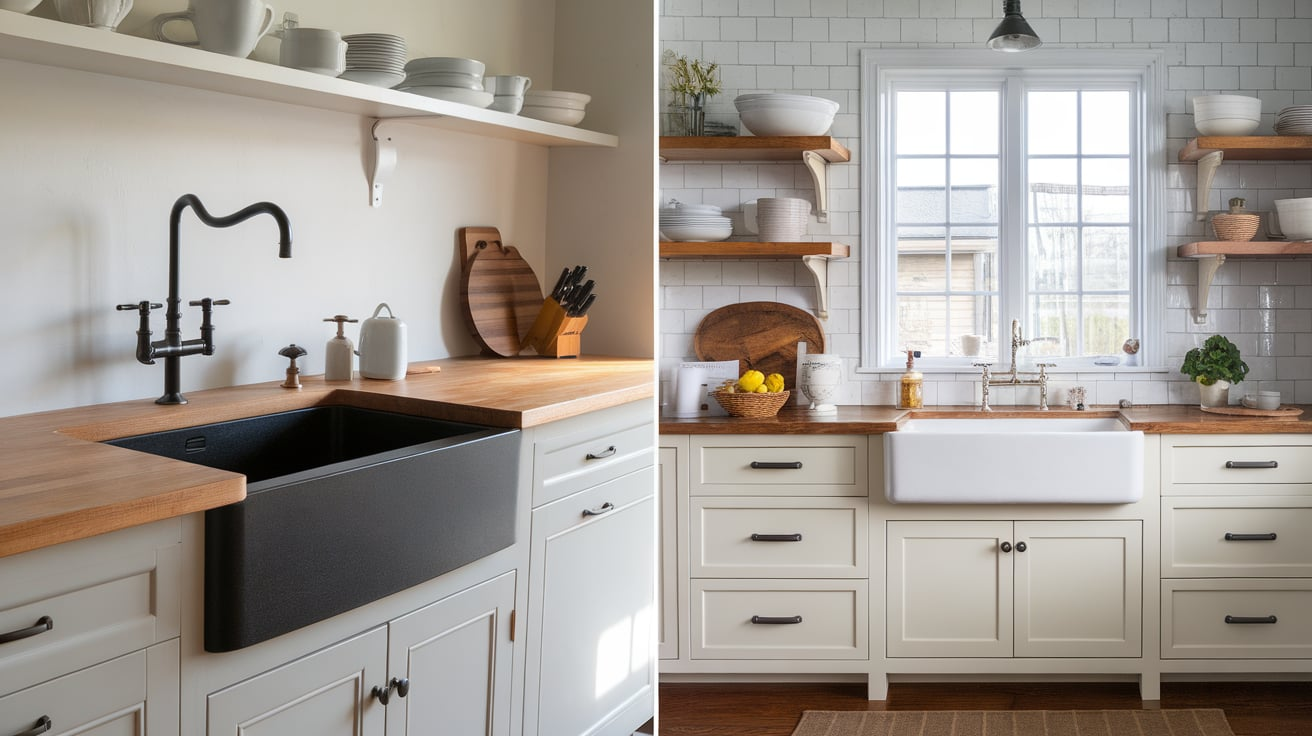
Installing an apron or farmhouse sink isn’t always as easy as swapping out a standard sink. These styles are usually heavier and deeper, which means the cabinet often needs some adjustment.
Most apron-front sinks are installed as undermounts, sitting just below the countertop to create a smooth, seamless edge.
Some newer apron sinks are designed as drop-in models, which makes installation a bit simpler and suitable for standard cutouts.
Farmhouse sinks, on the other hand, typically need a custom cabinet base to support their weight and exposed front. The front panel actually replaces part of the cabinet face, so it must be trimmed or built to fit perfectly.
Getting the measurements right is essential. Without proper support, the sink could shift, crack, or even cause long-term water damage over time.
4. Material Options and Durability
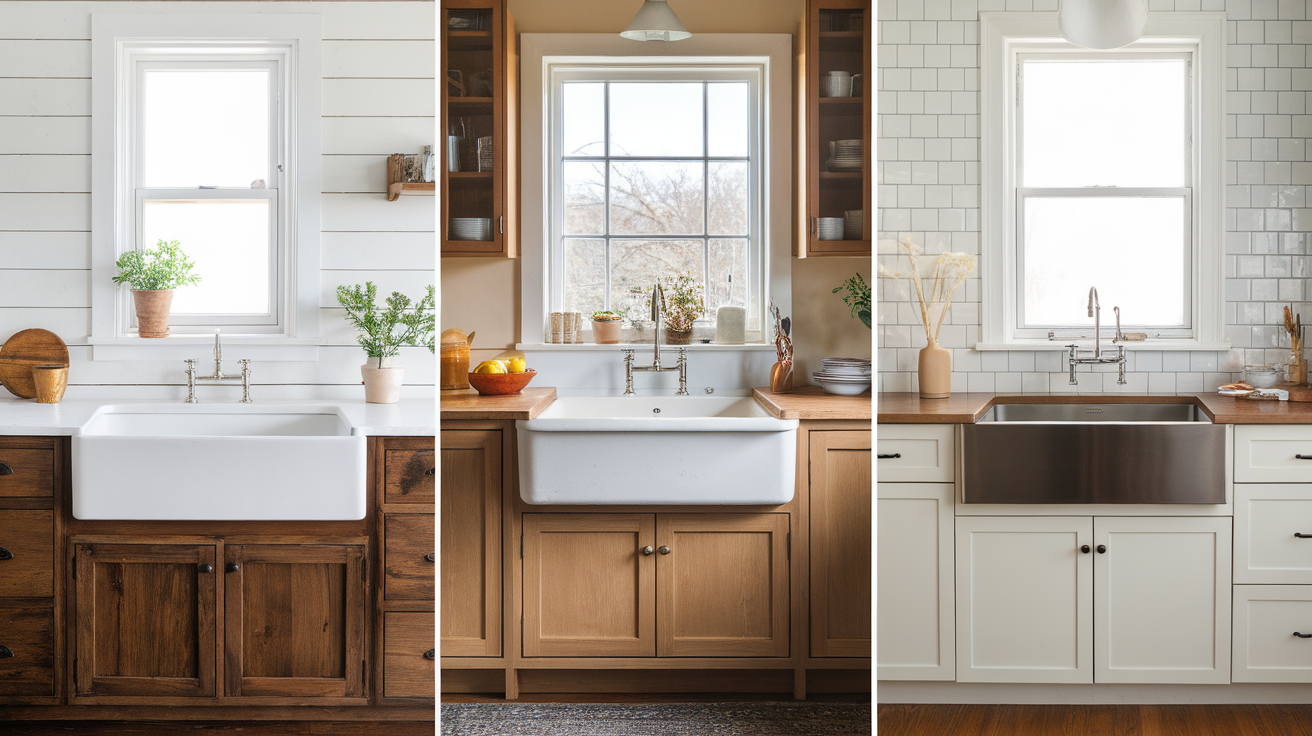
When choosing between an apron or farmhouse sink, the material you pick affects how it looks, feels, and holds up over time. Your final choice should match your cooking habits, cleaning preferences, and overall kitchen design.
- Fireclay is a popular choice for farmhouse sinks. It’s made by molding clay and firing it at high temperatures, creating a strong, smooth, and glossy surface. It’s highly resistant to stains and scratches, making it ideal for busy kitchens.
- Cast iron sinks have an enamel coating and a solid, vintage feel. They’re very durable, but the enamel can chip if heavy items are dropped, and the exposed metal underneath may rust.
- Stainless steel is more common in modern apron sinks. It’s lightweight, tough, and easy to clean, though it may show water spots and fine scratches over time. It’s a good choice if you want a sleek, low-maintenance option.
Generally, fireclay and cast iron work best with traditional farmhouse styles, while stainless steel and composite sinks pair well with modern or transitional kitchen designs.
5. Cost Comparison: Budgeting for Your Remodel

Sink prices vary by material and size – Farmhouse and apron sinks range widely in cost based on what they’re made of and how big they are.
- Fireclay and cast iron sinks: Typically cost between $400 and $1,200 (excluding installation).
- Stainless steel apron sinks: Usually more affordable, ranging from $250 to $800.
- Total cost depends on: Material, size, brand, and whether your cabinets need changes.
- Extra costs may include: Custom cabinetry, reinforced supports, and countertop modifications.
- Professional installation might be needed: Heavier sinks require proper support and expert handling.
- Easier during full remodels: It’s simpler to include a farmhouse sink in a full kitchen renovation.
- Retrofitting adds expense: Expect additional costs for cabinet adjustments and plumbing updates.
6. Resale Value in The Future
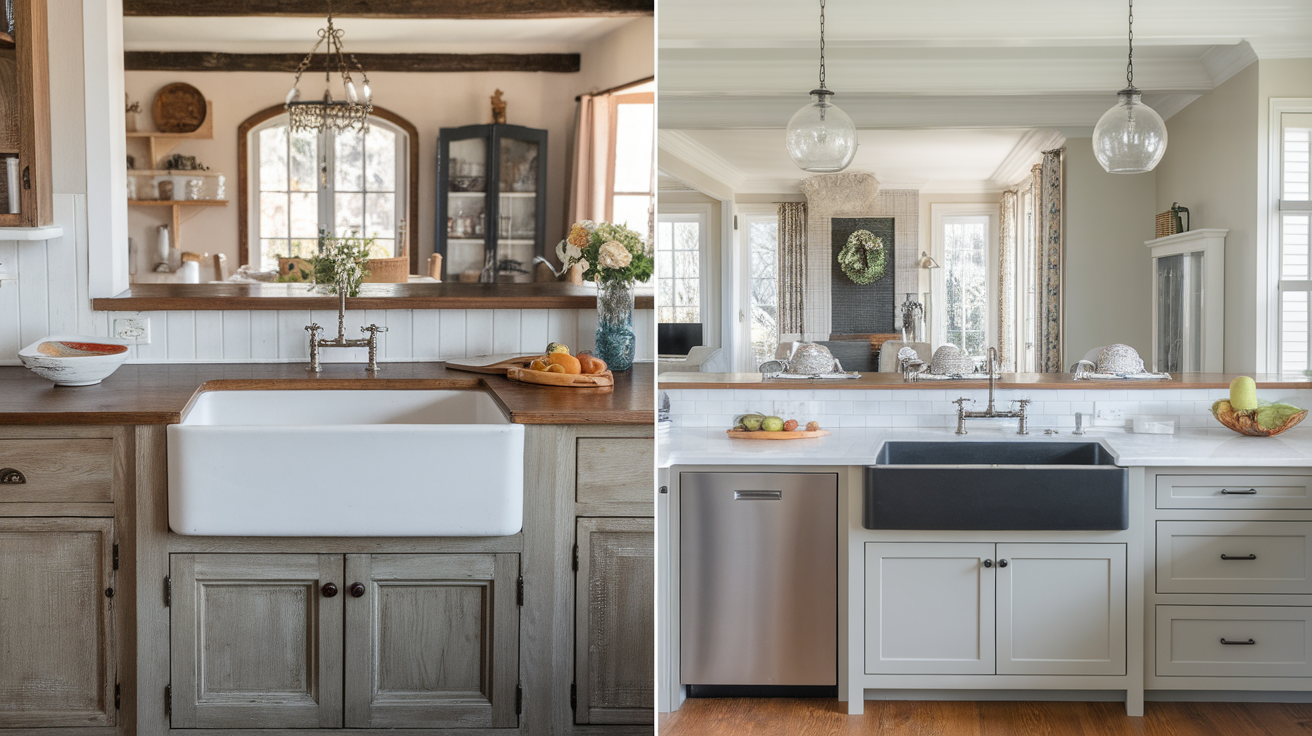
Farmhouse sinks are often seen as a desirable feature in real estate listings thanks to their timeless charm and strong visual appeal.
They instantly add character to a kitchen and are especially attractive to buyers who love rustic, vintage, or country-inspired designs.
Apron-front sinks with clean lines and neutral finishes, such as stainless steel or matte black, offer greater versatility.
They can complement both modern and transitional spaces, making them a safer choice if you’re thinking about resale value.
While trends can shift, neutral, high-quality sinks tend to hold their appeal longer. If you’re remodeling with future buyers in mind, consider how your sink choice will fit a wide range of tastes.
Apron vs Farmhouse Sink: Maintenance and Cleaning Tips
I clean my sink to keep it looking good and lasting longer. Here’s how I suggest taking care of fireclay, cast iron, and stainless steel sinks.
| Sink Type | Care Tip |
|---|---|
| Fireclay | Easy to clean with mild soap and a soft sponge |
| Fireclay | Naturally resists stains from coffee, wine, and food scraps |
| Cast Iron | Avoid abrasive cleaners to protect the enamel finish |
| Cast Iron | Can chip if hit hard, exposing the metal underneath |
| Stainless Steel | Resists stains but shows water spots and fingerprints |
| Stainless Steel | Wipe dry after use to reduce water spots and keep it looking polished |
| Stainless Steel | May develop fine scratches and dull areas over time |
| All Types | Match the sink to your cleaning habits and lifestyle |
Apron vs Farmhouse: Which Sink Is Right for You?
Choosing between an apron sink and a farmhouse sink depends on your lifestyle, kitchen habits, and design goals. If you love cooking large meals, need space for big pots, or want a sink that stands out as a focal point, either one could work.
However, the style and material you choose will significantly influence the overall feel of your kitchen.
The pros of farmhouse sinks include their deep basins, classic charm, and a cozy, timeless vibe. However, they often require custom cabinets and professional installation.
Apron sinks, especially modern styles, offer similar space but come in a wider range of materials and may fit transitional or contemporary kitchens better.
Ask yourself:
- Do I want a rustic or modern look?
- Am I doing a full remodel or working with existing cabinets?
- What kind of maintenance am I okay with?
Conclusion
Apron and farmhouse sinks may look alike, but understanding the difference makes it easier to pick what fits best in your kitchen.
A farmhouse sink brings a cozy, timeless feel with its deep basin and classic charm, perfect for traditional spaces. An apron-front sink, on the other hand, gives you that same exposed front but works in both modern and rustic designs.
Think about how you cook, how much space you have, and whether this is part of a full remodel or just a small update. I leaned toward fireclay for warmth, but stainless steel is great if you want a cleaner, more modern look.
Both options are durable and practical, so you really can’t go wrong. Go with the one that feels right for your home – something you’ll enjoy using and seeing every single day. That’s the best choice.


